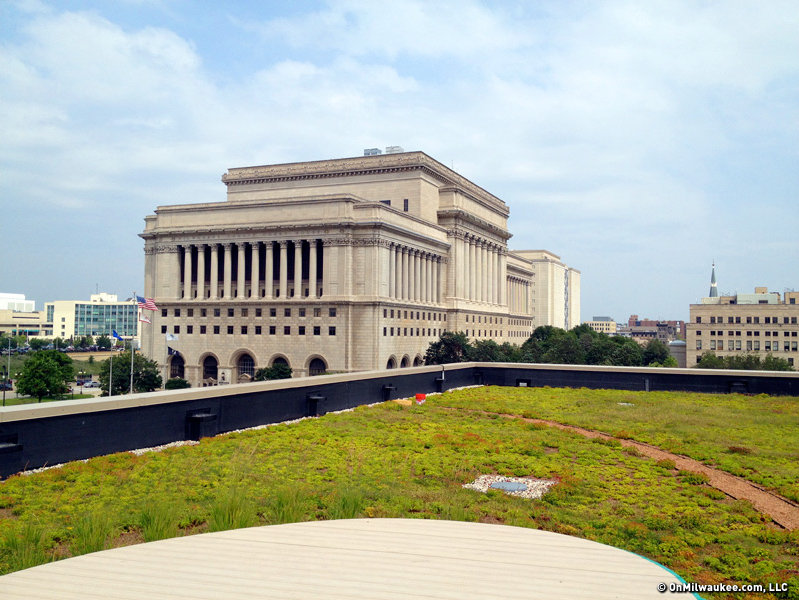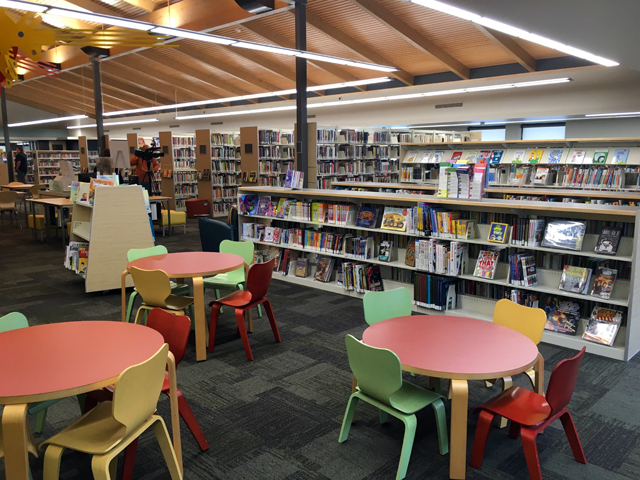In May 2011, we visited the Milwaukee Public Library’s recently installed green roof, which boasted not only a couple rows of solar panels, but 33,000 square feet of rainwater capturing and temperature moderating plants.
Back then, the plants were in but they were little more than seedlings, so the roof didn’t look very green. This week, I stopped in to check on the progress.
Three years later, the roof is a lush carpet of ground covering plants, especially a variety of sedums as well as chives and some grasses. It’s mostly green -- though the green refers to its eco-friendliness as much as the color of the vegetation -- but there are some reds, yellows and an attractive rust hue, too.
"The sedum some of it has more of a reddish hue, or purply, it kind of depends on what’s doing best," says librarian Anna Donovan, who has been leading tours of the roof since it was installed in 2010. "There’s a lot of variation in color. Earlier in the spring there’s a period when all the chives are blooming purple and that’s pretty nice.
"(The appearance) fluctuates. I think originally they thought it would be very impressive, lush greenery, but it’s Wisconsin, we had a really rough winter. If you come here in April it won’t look as good as it looks in June. In June it looks really great. It works even if it doesn’t look as spectacular as people might have expected."
There are some bare spots, but Donovan says that’s pretty normal and it fluctuates, too, depending on the weather.
"There have been times when it has been totally filled," she says. "But much of what is accomplished (by the roof) is accomplished beneath the sedum anyway."
Since it was installed, the roof has prevented 2.82 million gallons of rainwater entering the city’s storm sewer system.
"For an inch of rain the roof collects about 18,595 gallons of water. Typical rainfall is 3/4-inch to an inch. So, if that’s an average, each time it rains it stores about 18,595 gallons of water."
That means the roof gains more than 155,000 pounds during a typical rainfall. Luckily, the roof was built with the idea that another floor would be added. That didn’t happen but the result is that the deck is strong enough to support that extra burden.
The roof also helps moderate the roof’s temperature. On a sunny, 80-degree day a typical Downtown roof would heat up to 185 degrees. But the library’s roof only reaches about 85 degrees, which means the air conditioning system doesn’t have to work as hard to keep the building at a comfortable temperature.
According to the library’s Brooke VandeBerg, the library saved about $36,000 in energy costs last year thanks to the solar panels, the roof plantings and some other modifications like more efficient light bulbs and steam trap repair and replacement.
Proposed surcharges on solar power, however, threaten to diminish that savings, which is roughly 1-2 percent of the Central Library’s energy thirst.
However, it was enough to earn MPL awards from the Urban Libraries Council and the U.S. Department of Energy’s Better Buildings Challenge.
Though the roof was designed to be low-maintenance and it has proved to be more or less that, according to Donovan.
"They originally told us it would be very low maintenance," she says. "As vegetation would die off it would serve as fertilizer. It doesn’t need watering because of its water storage capability. These are supposed to be extremely hardy plants and over the winter they’re not covered except by snowfall. It’s supposed to be very self-sufficient.
"In general it’s left to survive our climate. The idea is that we shouldn’t have to constantly replant and fertilize like someone would do with a domesticated garden."
But, adds VandeBerg, the roof vegetation does require some tending, mostly in the form of daily weeding during the growing season.
You can see the green roof for yourself as the library offers free tours on Wednesdays and Saturdays through October. Details are here. It’s also open for Doors Open MKE on Saturday, Sept. 20.
Born in Brooklyn, N.Y., where he lived until he was 17, Bobby received his BA-Mass Communications from UWM in 1989 and has lived in Walker's Point, Bay View, Enderis Park, South Milwaukee and on the East Side.
He has published three non-fiction books in Italy – including one about an event in Milwaukee history, which was published in the U.S. in autumn 2010. Four more books, all about Milwaukee, have been published by The History Press.
With his most recent band, The Yell Leaders, Bobby released four LPs and had a songs featured in episodes of TV's "Party of Five" and "Dawson's Creek," and films in Japan, South America and the U.S. The Yell Leaders were named the best unsigned band in their region by VH-1 as part of its Rock Across America 1998 Tour. Most recently, the band contributed tracks to a UK vinyl/CD tribute to the Redskins and collaborated on a track with Italian novelist Enrico Remmert.
He's produced three installments of the "OMCD" series of local music compilations for OnMilwaukee.com and in 2007 produced a CD of Italian music and poetry.
In 2005, he was awarded the City of Asti's (Italy) Journalism Prize for his work focusing on that area. He has also won awards from the Milwaukee Press Club.
He has be heard on 88Nine Radio Milwaukee talking about his "Urban Spelunking" series of stories, in that station's most popular podcast.







